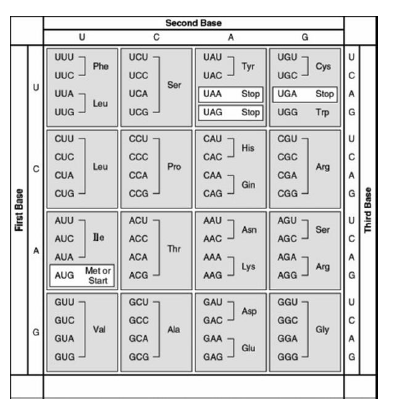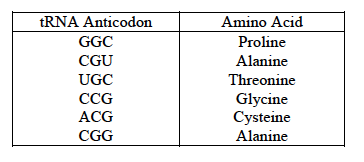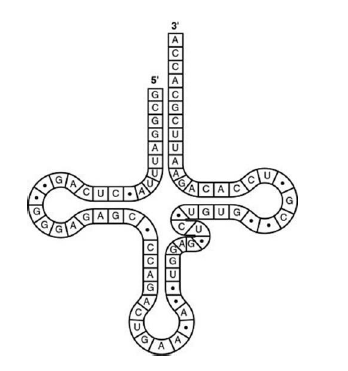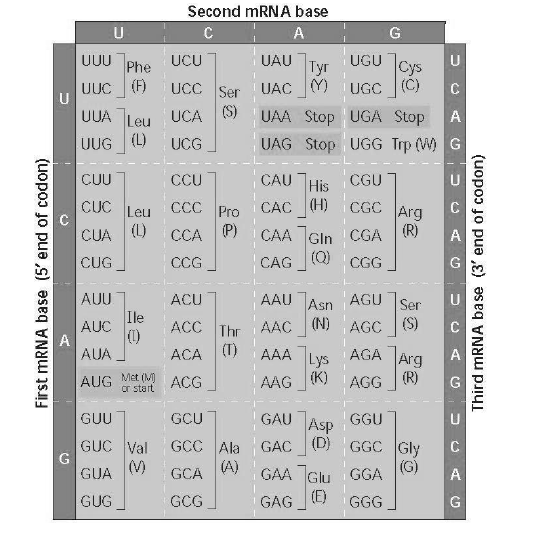1) Which of the following statements correctly describes Archibald Garrod's hypothesis for how "inborn errors of metabolism" such as alkaptonuria occur?
A) Metabolic enzymes require vitamin cofactors, and affected individuals have significant nutritional deficiencies.
B) Enzymes are made of DNA, and affected individuals lack DNA polymerase.
C) Certain metabolic reactions are carried out by ribozymes, and affected individuals lack key splicing factors.
D) Genes dictate the production of specific enzymes, and affected individuals have genetic defects that cause them to lack certain enzymes.
D
2) A particular triplet of bases in the template strand of DNA is 5′-AGT-3′. What would be the corresponding codon for the mRNA that is transcribed?
A) 3′-UCA-5′
B) 3′-UGA-5′
C) 5′-TCA-3′
D) 3′-ACU-5′
A
3) The genetic code is essentially the same for all organisms. From this, one can logically assume which of the following statements to be true?
A) A gene from an organism can theoretically be expressed by any other organism.
B) DNA was the first genetic material.
C) The same codons in different organisms translate into different amino acids.
D) Different organisms have different types of amino acids.
A

4) Use the figure to answer the question.
The figure shows a simple metabolic pathway. According to Beadle and Tatum's hypothesis, how many genes are necessary for this pathway?
A) 1
B) 2
C) 3
D) It cannot be determined from the pathway.
B

5) Use the figure to answer the question.
Refer to the metabolic pathway illustrated. If A, B, and C are all required for growth, a strain that is mutant for the gene-encoding enzyme A would be able to grow on medium supplemented with which of the following nutrient(s)?
A) nutrient A only
B) either nutrient B or C
C) nutrient C only
D) nutrients A and C
B

6) Use the figure to answer the question.
Refer to the metabolic pathway illustrated. If A, B, and C are all required for growth, a strain mutant for the gene encoding enzyme B would be able to grow on medium supplemented with which of the following nutrient(s)?
A) nutrient A only
B) nutrient B only
C) nutrient C only
D) nutrients A and C
C

Which of the following sequences of nucleotides are possible in the template strand of DNA that would code for the polypeptide sequence Phe-Leu-Ile-Val?
A) 5′-TTG-CTA-CAG-TAG-3′
B) 5′-AUG-CTG-CAG-TAT-3′
C) 3′-AAA-AAT-ATA-ACA-5′
D) 3′-AAA-GAA-TAA-CAA-5′
D

What amino acid sequence will be generated, based on the following mRNA codon sequence?
5′-AUG-UCU-UCG-UUA-UCC-UUG-3′
A) Met-Arg-Glu-Arg-Glu-Arg
B) Met-Glu-Arg-Arg-Glu-Leu
C) Met-Ser-Leu-Ser-Leu-Ser
D) Met-Ser-Ser-Leu-Ser-Leu
D

Refer to the figure. Which of the triplets below is a possible anticodon for a tRNA that transports proline to a ribosome?
A) 3′-UUC-5′
B) 3′-CCG-5′
C) 3′-GGC-5′
D) 3′-CCC-5′
C
10) Which of the following statements supports the one gene-one enzyme hypothesis?
A) A mutation in a single gene can result in a defective protein.
B) Alkaptonuria results when individuals lack multiple enzymes involved in the catalysis of homogentisic acid.
C) Sickle-cell anemia results in normal hemoglobin.
D) Multiple antibody genes can code for different related proteins, depending on the splicing that takes place post-transcriptionally.
A
11) Which of the following characteristics is directly related to the coding of a single amino acid during the process of translation?
A) the base sequence of the tRNA
B) the amino acetyl tRNA synthase
C) the three-base sequence of mRNA
D) the complementarity of DNA and RNA
C
12) Which of the following processes occurs during transcription?
A) DNA is replicated
B) RNA is synthesized
C) proteins are synthesized
D) mRNA attaches to ribosomes
B
13) Which of the following molecular structures contain codons?
A) a protein
B) mRNA
C) tRNA
D) rRNA
B
14) The genetic code is redundant. What is meant by this statement?
A) A single codon can specify the addition of more than one amino acid.
B) The genetic code is different for different domains of organisms.
C) The genetic code is universal (the same for all organisms).
D) More than one codon can specify the addition of the same amino acid.
D
15) Once researchers identified DNA as the molecule responsible for transmitting heritable traits, they asked how information was transferred from the DNA in the nucleus to the site of protein synthesis in the cytoplasm. Which of the following statements correctly describes the mechanism of information transfer in eukaryotes that accomplishes this task?
A) DNA from a single gene is replicated and transferred to the cytoplasm, where it serves as a template for protein synthesis.
B) Messenger RNA is transcribed from a single gene and transfers information from the DNA in the nucleus to the cytoplasm, where protein synthesis takes place.
C) Histone proteins in the chromosomes transfer information from the nucleus to the ribosome, where protein synthesis takes place.
D) Transfer RNA takes information from DNA directly to a ribosome, where protein synthesis takes place.
B
16) According to the central dogma, what is the intermediate molecule involved in the flow of information in a cell that should go in the blank?
DNA → ________ → Proteins
A) mtDNA
B) rRNA
C) mRNA
D) tRNA
C
17) Codons are three-base sequences in mRNA that specify the addition of a single amino acid to the growing protein chain during translation. How do eukaryotic codons and prokaryotic codons compare?
A) Prokaryotic codons usually contain different bases than those of eukaryotes.
B) Prokaryotic codons usually specify different amino acids than those of eukaryotes.
C) The translation of codons is mediated by tRNAs in eukaryotes, but translation requires no intermediate molecules such as tRNAs in prokaryotes.
D) Codons are a nearly universal language among all organisms.
D
18) Which of the following processes occurs in prokaryotes but not in eukaryotes?
A) post-transcriptional splicing
B) transcription and translation occur simultaneously
C) translation in the absence of a ribosome
D) gene splicing
B
19) Which of the following statements best describes the termination of transcription in prokaryotes?
A) RNA polymerase transcribes through the polyadenylation signal, causing proteins to associate with the transcript and cut it free from the polymerase.
B) RNA polymerase transcribes through the terminator sequence, causing the polymerase to separate from the DNA and release the transcript.
C) Once transcription has initiated, RNA polymerase transcribes until it reaches the end of the chromosome.
D) RNA polymerase transcribes through a stop codon, causing the polymerase to stop advancing through the gene and release the mRNA.
B
20) In eukaryotes, there are several different types of RNA polymerase. Which type is involved in transcription of mRNA for a globin protein?
A) RNA polymerase I
B) RNA polymerase II
C) RNA polymerase III
D) primase
B
21) Transcription in eukaryotes requires which of the following molecules in addition to RNA polymerase?
A) anticodons
B) ribosomes and tRNA
C) several transcription factors
D) aminoacyl-tRNA synthetase
C
22) Which of the following statements best describes the significance of the TATA box in the promoters of eukaryotes?
A) It is the recognition site for the binding of a specific transcription factor.
B) It sets the reading frame of the mRNA during translation.
C) It is the recognition site for ribosomal binding during translation.
D) It is the recognition site for ribosomal binding during transcription.
A
23) Which of the following processes occurs in eukaryotic gene expression?
A) mRNA, tRNA, and rRNA are translated.
B) RNA polymerase binds to the terminator sequence.
C) A cap is added to the 5′ end of the mRNA.
D) RNA polymerase requires tRNA to elongate the molecule.
C
24) Which of the following statements correctly describes a ribozyme?
A) It is a catalyst that uses RNA as a substrate.
B) It is an RNA with catalytic activity.
C) It is an enzyme that catalyzes the association between the large and small ribosomal subunits.
D) It is an enzyme that synthesizes RNA as part of the transcription process.
B
25) Which of the following processes correctly describes alternative RNA splicing?
A) It is a mechanism for increasing the rate of translation.
B) It can allow the production of proteins of different sizes and functions from a single mRNA.
C) It can allow the production of similar proteins from different RNAs.
D) It increases the rate of transcription.
B
26) In the structural organization of many eukaryotic genes, individual exons may be related to which of the following?
A) the sequence of the intron that immediately precedes each exon
B) the number of polypeptides making up the functional protein
C) the various domains of the polypeptide product
D) the number of start sites for transcription
C
27) In an experimental situation, a student researcher inserts an mRNA molecule into a eukaryotic cell after she has removed its 5′ cap and poly-A tail. Which of the following processes would you expect her to find to have occurred?
A) The mRNA is quickly converted into a ribosomal subunit.
B) The cell adds a new poly-A tail to the mRNA.
C) The mRNA attaches to a ribosome and is translated, but more slowly.
D) The molecule is digested by enzymes because it is not protected at the 5′ end.
D
28) Use this model of a eukaryotic transcript to answer the following question.
E = exon and I = intron
5′-UTR E1 I1 E2 I2 E3 I3 E4 UTR-3′
Which components of the previous molecule will also be found in mRNA in the cytosol?
A) 5′-UTR I1 I2 I3 UTR-3′
B) 5′-E1 E2 E3 E4-3′
C) 5′-UTR E1 E2 E3 E4 UTR-3′
D) 5′-E1 I1 E2 I2 E3 I3 E4-3′
C
29) Which one of the following statements about RNA processing is correct?
A) Exons are cut out before mRNA leaves the nucleus.
B) Ribozymes may function in RNA splicing.
C) RNA splicing can be catalyzed by tRNA.
D) A primary transcript is often much shorter than the final RNA molecule that leaves the nucleus.
B
30) How does the primary transcript in the nucleus of a eukaryotic cell compare to the functional mRNA?
A) the primary transcript is the same size as the mRNA
B) the primary transcript is larger than the mRNA
C) the primary transcript is smaller than the mRNA
D) both the primary transcript and mRNA contain introns
B
31) How does the primary transcript in the nucleus of a prokaryotic cell compare to the functional mRNA?
A) the primary transcript is larger than the mRNA
B) the primary transcript is smaller than the mRNA
C) the primary transcript and the mRNA both contain introns
D) the primary transcript is the same size as the mRNA
D
32) A particular triplet of bases in the coding sequence of DNA is AAA. The anticodon on the tRNA that binds the mRNA codon is ________.
A) TTT
B) UUA
C) UUU
D) AAA
D
33) Accuracy in the translation of mRNA into the primary structure of a polypeptide depends on specificity in the ________.
A) binding of ribosomes to mRNA
B) binding of the anticodon to small subunit of the ribosome
C) attachment of amino acids to rRNAs
D) binding of the anticodon to the codon and the attachment of amino acids to tRNAs
D
34) What would be the consequence of a mutation in a bacterial cell that produces a defective aminoacyl-tRNA synthetase that attaches a lysine instead of the normal phenylalanine to tRNAs with the anticodon AAA?
A) None of the proteins in the cell will contain phenylalanine.
B) Proteins in the cell will include lysine instead of phenylalanine at amino acid positions specified by the codon UUU.
C) The cell will compensate for the defect by attaching phenylalanine to tRNAs with lysine-specifying anticodons.
D) The ribosome will skip a codon every time a UUU is encountered.
B
35) In bacteria, there are 61 mRNA codons that specify an amino acid, but only 45 tRNAs. Which of the following statements explains this fact?
A) Some tRNAs have anticodons that recognize four or more different codons.
B) The rules for base pairing between the third base of a codon and tRNA are flexible.
C) Many codons are never used, so the tRNAs that recognize them are dispensable.
D) The DNA codes for all 61 tRNAs, but some are then destroyed.
B
36) Which of the following processes is the first event to take place in translation in eukaryotes?
A) base pairing of activated methionine-tRNA to AUG of the messenger RNA
B) binding of the larger ribosomal subunit to smaller ribosomal subunits
C) the ribosome reaches a stop codon
D) the small subunit of the ribosome recognizes and attaches to the 5′ cap of mRNA
D
37) Which of the following statements correctly describes the function of a signal peptide?
A) It directs an mRNA molecule into the cisternal space of the ER.
B) It terminates translation of messenger RNA.
C) It helps target a protein to the ER.
D) It signals the initiation of transcription.
C
38) What is the function of the release factor during translation in eukaryotes?
A) It binds to the stop codon in the A site in place of a tRNA.
B) It releases the amino acid from its tRNA to allow the amino acid to form a peptide bond.
C) It supplies a source of energy for termination of translation.
D) It releases the ribosome from the ER to allow polypeptides into the cytosol.
A

39) Use the following information to answer the question.
A part of an mRNA molecule with the following sequence is being read by a ribosome: 5′-CCG-ACG-3′ (mRNA). The following charged transfer RNA molecules (with their anticodons shown in the 3′ to 5′ direction) are available. Two of them can correctly match the mRNA so that a dipeptide can form.
Which of the following dipeptides will form from this mRNA?
A) cysteine-alanine
B) proline-threonine
C) glycine-cysteine
D) alanine-alanine
B

40) Use the following information to answer the question.
A part of an mRNA molecule with the following sequence is being read by a ribosome: 5′-CCG-ACG-3′ (mRNA). The following charged transfer RNA molecules (with their anticodons shown in the 3′ to 5′ direction) are available. Two of them can correctly match the mRNA so that a dipeptide can form.
Which of the following anticodons in the first tRNA to bind will complement this mRNA?
A) 3′-GGC-5′
B) 5′-GGC-3′
C) 5′-UGC-3′
D) 3′-UGC-5′
A

41) Use the figure to answer the question.
What type of bonding is responsible for maintaining the shape of the tRNA molecule shown in the figure?
A) ionic bonding between phosphates
B) hydrogen bonding between base pairs
C) van der Waals interactions between hydrogen atoms
D) peptide bonding between amino acids
B

42) Use the figure to answer the question.
The figure represents tRNA that recognizes and binds a particular amino acid (in this instance, phenylalanine). Which codon on the mRNA strand codes for this amino acid?
A) 5′-UGG-3′
B) 3′-GUG-5′
C) 5′-GUA-3′
D) 5′-UUC-3′
D

43) Use the figure to answer the question.
The tRNA shown in the figure has its 3′ end projecting beyond its 5′ end. Which of the following processes will occur at this 3′ end?
A) The amino acid binds covalently.
B) The excess nucleotides (ACCA) will be cleaved off at the ribosome.
C) The small and large subunits of the ribosome will attach to it.
D) The 5′ cap of the mRNA will become covalently bound.
A
44) Which of the following properties is associated with a protein that will be secreted from a eukaryotic cell?
A) It must be translated by a ribosome that remains free within the cytosol.
B) Its signal sequence must target it to the ER, after which it goes to the Golgi.
C) Its signal sequence must be cleaved off before the polypeptide can enter the ER.
D) Its signal sequence must target it to the plasma membrane, where it causes exocytosis.
B
45) Which of the following molecules are required for the process of translation?
A) mRNA, tRNA, DNA, and rRNA
B) mRNA, DNA, and rRNA
C) mRNA, tRNA, and rRNA
D) mRNA, tRNA, and DNA
C
46) During the elongation phase of translation, which site in the ribosome represents the location where a codon is being read?
A) E site
B) P site
C) A site
D) the large ribosomal subunit
C
47) Once a peptide bond has been formed between the amino acid attached to the tRNA in the P site and the amino acid associated with the tRNA in the A site, what process occurs next?
A) translocation
B) reading of the next codon of mRNA
C) initiation
D) The codon-anticodon hydrogen bonds holding the tRNA in the A site are broken.
A
48) Which one of the following structures, if missing, would usually prevent translation from starting?
A) exon
B) 5′ cap
C) AUG codon
D) poly-A tail
C
49) Which of the following processes occurs when termination of translation takes place?
A) The end of the mRNA molecule is reached.
B) A stop codon is reached.
C) The 5′ cap is reached.
D) The poly-A tail is reached.
B
50) Post-translational modifications of proteins may include which of the following processes?
A) removal of introns
B) addition of a 5′ cap
C) addition of a poly-A tail
D) addition of carbohydrates to form a glycoprotein
D
51) Which of the following statements is true about protein synthesis in prokaryotes?
A) Extensive RNA processing is required before prokaryotic transcripts can be translated.
B) Translation can begin while transcription is still in progress.
C) Prokaryotic cells have complicated mechanisms for targeting proteins to the appropriate cellular organelles.
D) Unlike eukaryotes, prokaryotes require no initiation or elongation factors.
B
52) Which of the following types of mutation, resulting in an error in the mRNA just after the AUG start of translation, is likely to have the most serious effect on the polypeptide product?
A) a deletion of a codon
B) a deletion of two nucleotides
C) a substitution of the third nucleotide in an ACC codon
D) a substitution of the first nucleotide of a GGG codon
B
53) Which of the following statements correctly describes the effect a nonsense mutation would have on a gene?
A) It changes an amino acid in the encoded protein.
B) It has no effect on the amino acid sequence of the encoded protein.
C) It introduces a premature stop codon into the mRNA.
D) It alters the reading frame of the mRNA.
C
54) Which of the following DNA mutations is most likely to damage the protein it specifies?
A) a base-pair deletion
B) an addition of three nucleotides
C) a substitution in the last base of a codon
D) a codon deletion
A
55) The most commonly occurring mutation in people with cystic fibrosis is a deletion of a single codon. What is the result of this type of mutation?
A) a base-pair substitution
B) a frameshift mutation
C) a polypeptide missing an amino acid
D) a nonsense mutation
C
56) Which of the following statements is the most current description of a gene?
A) a unit of heredity that causes formation of a phenotypic characteristic
B) a DNA subunit that codes for a single complete protein
C) a DNA sequence that is expressed to form a functional product: either RNA or polypeptide
D) a discrete unit of hereditary information that consists of a sequence of amino acids
C
57) How might a single base substitution in the sequence of a gene affect the amino acid sequence of a protein encoded by the gene?
A) Only a single amino acid could change, because the reading frame would be unaffected.
B) The amino acid sequence would be substantially altered, because the reading frame would change with a single base substitution.
C) All amino acids following the substitution would be affected, because the reading frame would be shifted.
D) It is not possible for a single base substitution to affect protein structure, because each codon is three bases long.
A
58) An original section of DNA has the base sequence AGCGTTACCGT. A mutation in this DNA strand results in the base sequence AGGCGTTACCGT. What type of mutation does this change represent?
A) a missense mutation
B) a point mutation
C) a silent mutation
D) frameshift mutation
D
59) A single base substitution mutation is likely to have a less deleterious effect when the base change exhibits which of the following results?
A) a stop codon
B) a codon that specifies the same amino acid as the original codon
C) an amino acid substitution that alters the tertiary structure of the protein
D) an amino acid substitution at the active site of an enzyme
B
60) Rank the following one-base point mutations with respect to their likelihood of affecting the structure of the corresponding polypeptide (from most likely to least likely).
1. insertion mutation deep within an intron
2. substitution mutation at the third position of a codon in an exon
3. substitution mutation at the second position of a codon in an exon
4. deletion mutation within the first exon of the gene
A) 1, 2, 3, 4
B) 4, 3, 2, 1
C) 2, 1, 4, 3
D) 3, 1, 4, 2
B
1) In eukaryotic cells, transcription cannot begin until
A) the two DNA strands have completely separated and exposed the promoter.
B) several transcription factors have bound to the promoter.
C) the 5 caps are removed from the mRNA.
D) the DNA introns are removed from the template.
B
2) Which of the following is not true of a codon?
A) It may code for the same amino acid as another codon.
B) It never codes for more than one amino acid.
C) It extends from one end of a tRNA molecule.
D) It is the basic unit of the genetic code.
C
3) The anticodon of a particular tRNA molecule is
A) complementary to the corresponding mRNA codon.
B) complementary to the corresponding triplet in rRNA.
C) the part of tRNA that bonds to a specific amino acid.
D) catalytic, making the tRNA a ribozyme
A
4) Which of the following is not true of RNA processing?
A) Exons are cut out before mRNA leaves the nucleus.
B) Nucleotides may be added at both ends of the RNA.
C) Ribozymes may function in RNA splicing.
D) RNA splicing can be catalyzed by spliceosomes.
A
5) Which component is not directly involved in translation?
A) GTP
B) DNA
C) tRNA
D) ribosomes
B

Using Figure 17.6, identify a 5′ → 3′ sequence of nucleotides in the DNA template strand for an mRNA coding for the polypeptide sequence Phe-Pro-Lys.
A) 5-UUUCCCAAA-3
B) 5-GAACCCCTT-3
C) 5-CTTCGGGAA-3
D) 5-AAACCCUUU-3
C
7) Which of the following mutations would be most likely to have a harmful effect on an organism?
A) a deletion of three nucleotides near the middle of a gene
B) a single nucleotide deletion in the middle of an intron
C) a single nucleotide deletion near the end of the coding sequence
D) a single nucleotide insertion downstream of, and close to, the start of the coding sequence
D